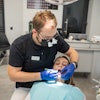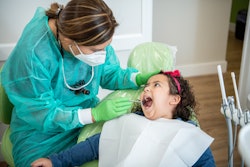
Dentists reported that pediatric pain management practices need to improve, because controlling pain, as well as anxiety or fear, in kids is a problem. The study was published on October 25 in the Journal of the American Dental Association.
Furthermore, dentists reported high use of evidence-based pain management (EBPM) strategies, low use of validated pain-assessment tools, and were very interested professional development opportunities focused on nonpharmacologic pain management, the authors wrote.
“Respondents view pain management as a complex, dynamic process that often requires an individualized approach,” wrote the co-authors, led by Dr. Caroline Sawicki, PhD, of the department of pediatric dentistry at New York University.
Dental pain is common among pediatric patients, yet it is understudied and often undertreated. To better understand dental pain management in children, understanding dentists’ practices and perceptions is necessary. The authors queried 625 pediatric dentists and residents using a survey. Of these participants, 89% were dentists and 11% were residents, according to the study.
Of all respondents, about 74% rated pain management extremely important in pediatric dentistry, and nearly 23% rated it as very important. Although both pain and anxiety or fear were endorsed by respondents as problems in pediatric dentistry, anxiety or fear were endorsed in greater frequency and magnitude. Nearly 63% of respondents rated managing pain as a big (20%) or moderate (43%) problem in their clinical practices. Furthermore, 88% of respondents rated dental anxiety or fear as a big (46%) or moderate (42%) problem, according to the study.
Additionally, dentists and residents reported using a variety of nonpharmacologic strategies -- including tell-show-do techniques, desensitization to the dental setting, and pharmacologic pain management strategies such as sedation and local and general anesthesia -- the authors wrote.
The most endorsed nonpharmacological strategies were distraction, tell-show-do techniques, and supportive language and praise. Topical and local anesthesia were used most to manage pain, with about 89% of respondents reporting their use. Furthermore, about 92% of clinicians reported not using any opioids, but about 60% reported giving nonopioids, they wrote.
The study had limitations. Though the American Academy of Pediatric Dentistry guidelines classify the use of nitrous oxide to help reduce anxiety and enhance effective communication as a basic behavior technique, several respondents wrote laughing gas in the survey’s open-text box under other pharmacologic therapies. This type of response indicated that they may not have remembered or considered nitrous oxide as a basic behavior guidance technique, the authors wrote.
In the future, observational and randomized controlled studies need to be conducted to determine the effectiveness of pharmacologic and nonpharmacologic pain management, patient characteristics associated with their effectiveness, and provider competency in delivering and implementing these techniques, they wrote.
“Follow-up studies aiming to understand provider perceptions of what needs to be improved in their pain management practices as well as provider-perceived comfort and competency using specific EBPM strategies could inform tailored knowledge mobilization and training efforts,” Sawicki and colleague wrote.




















